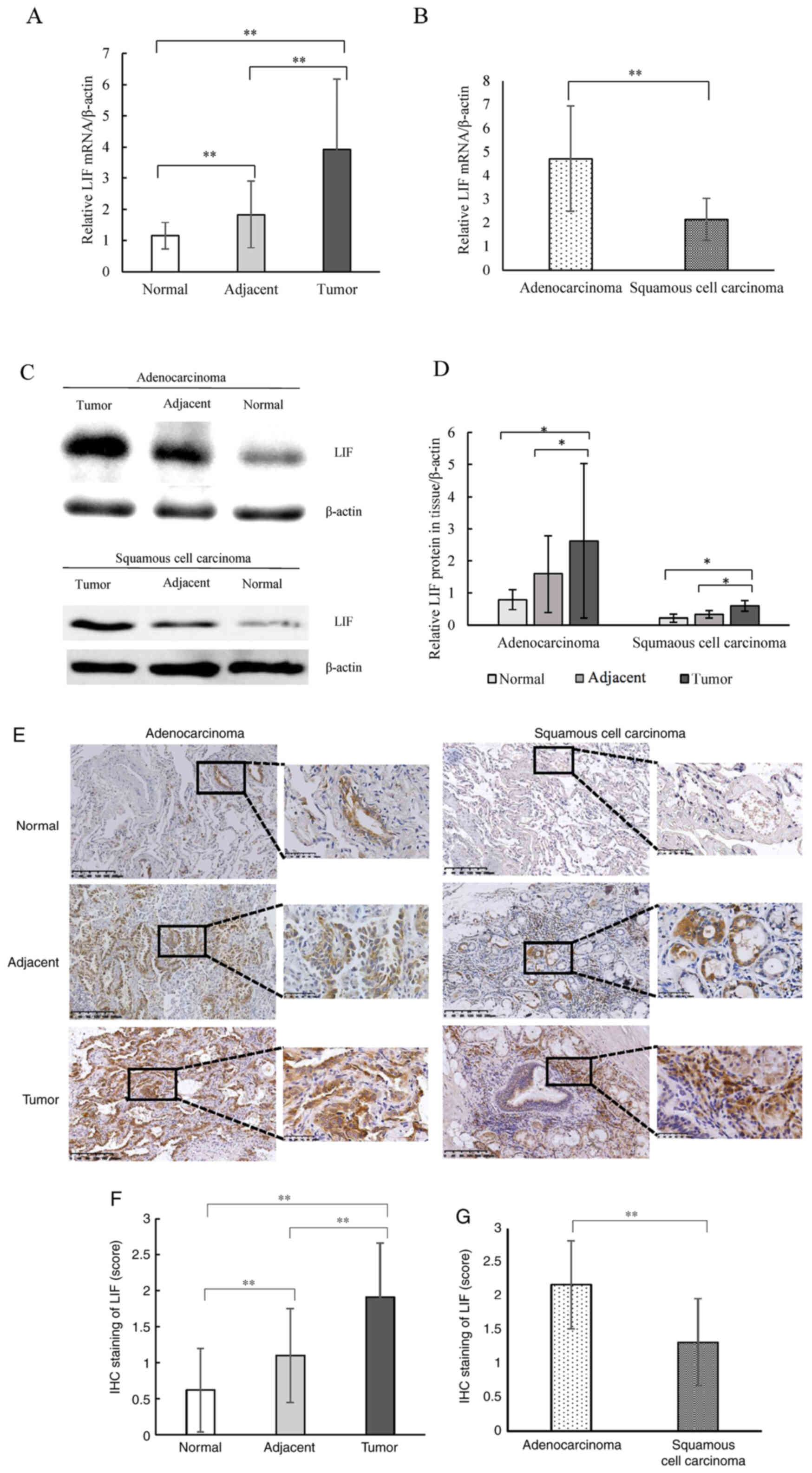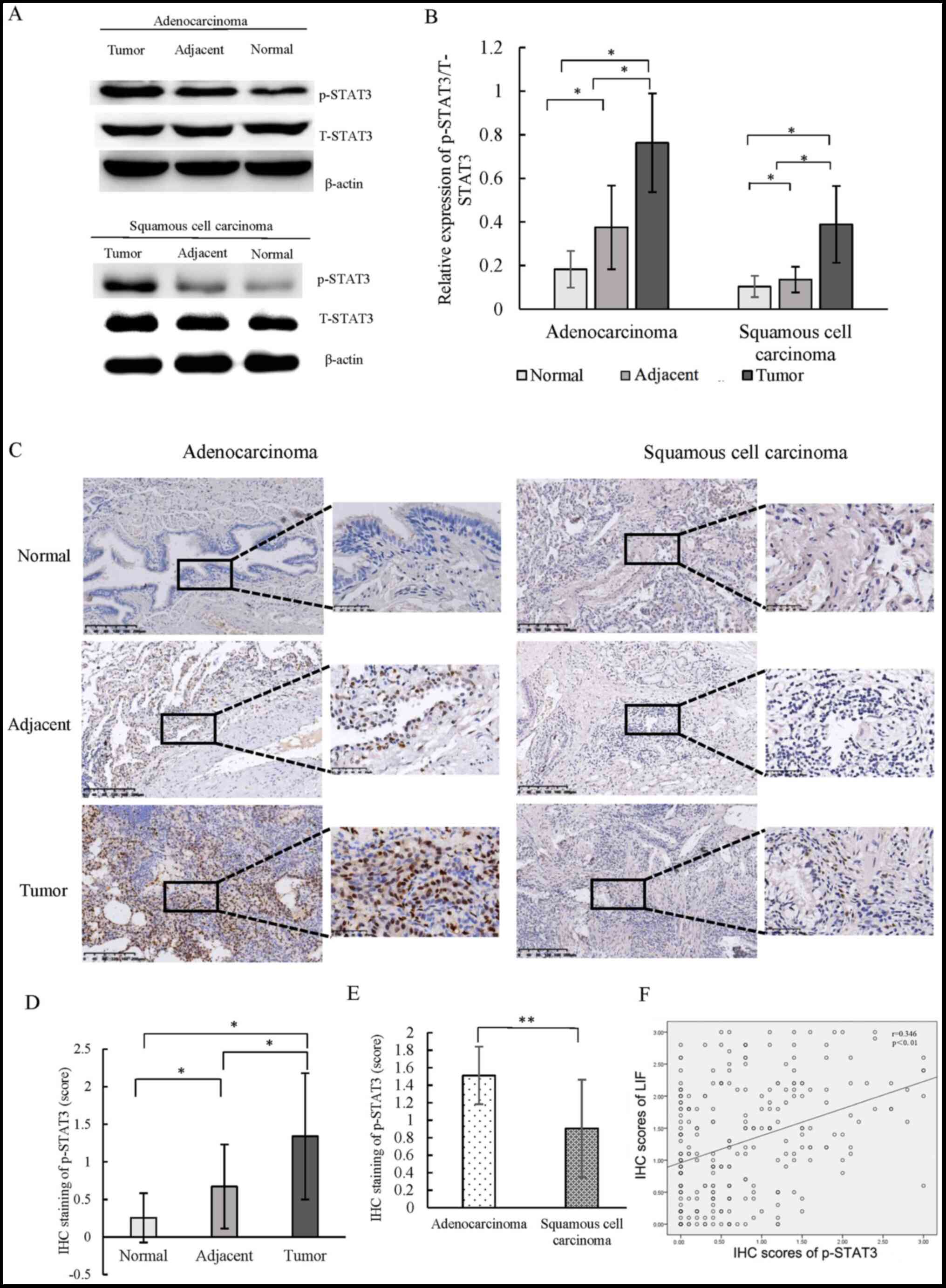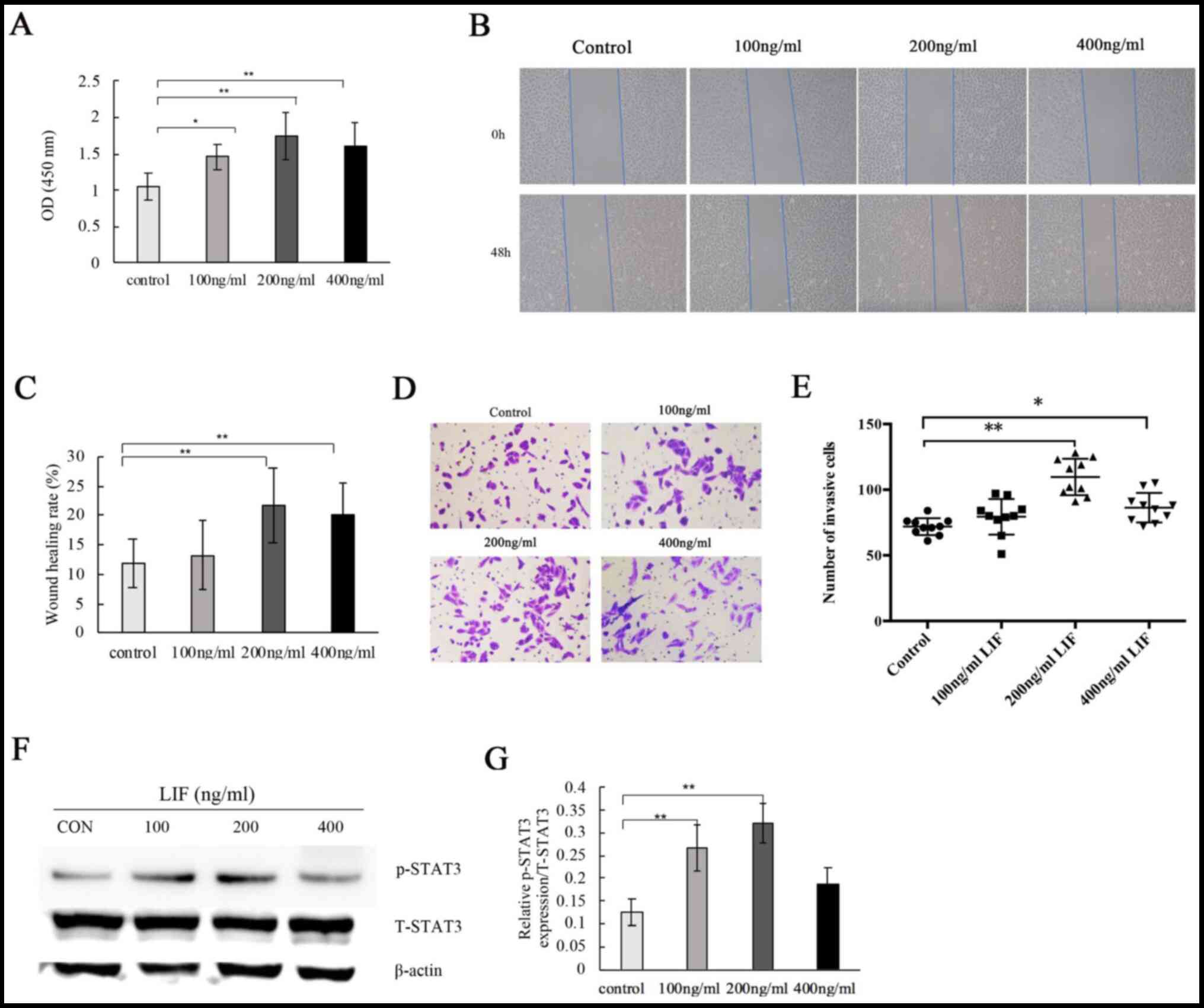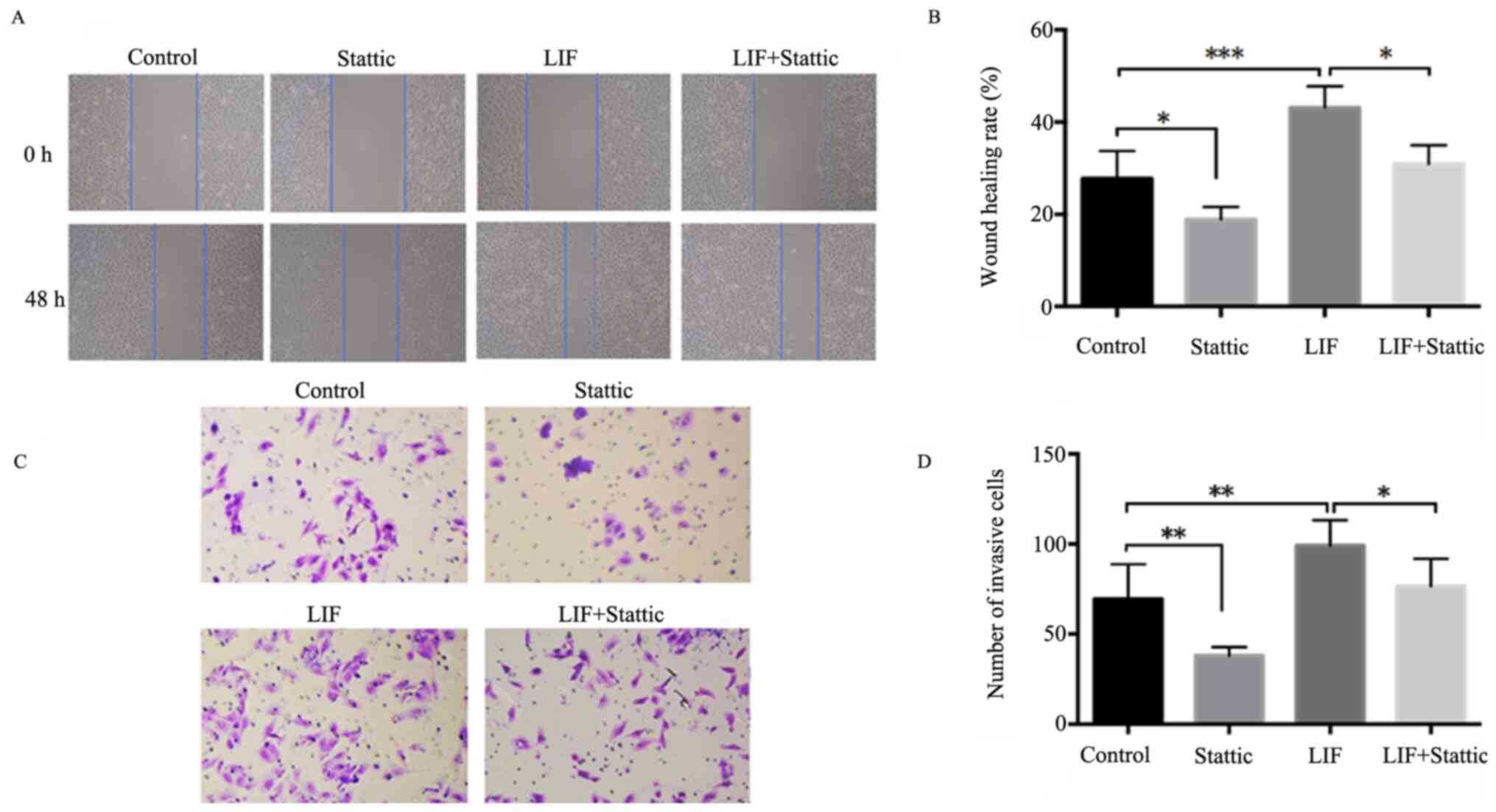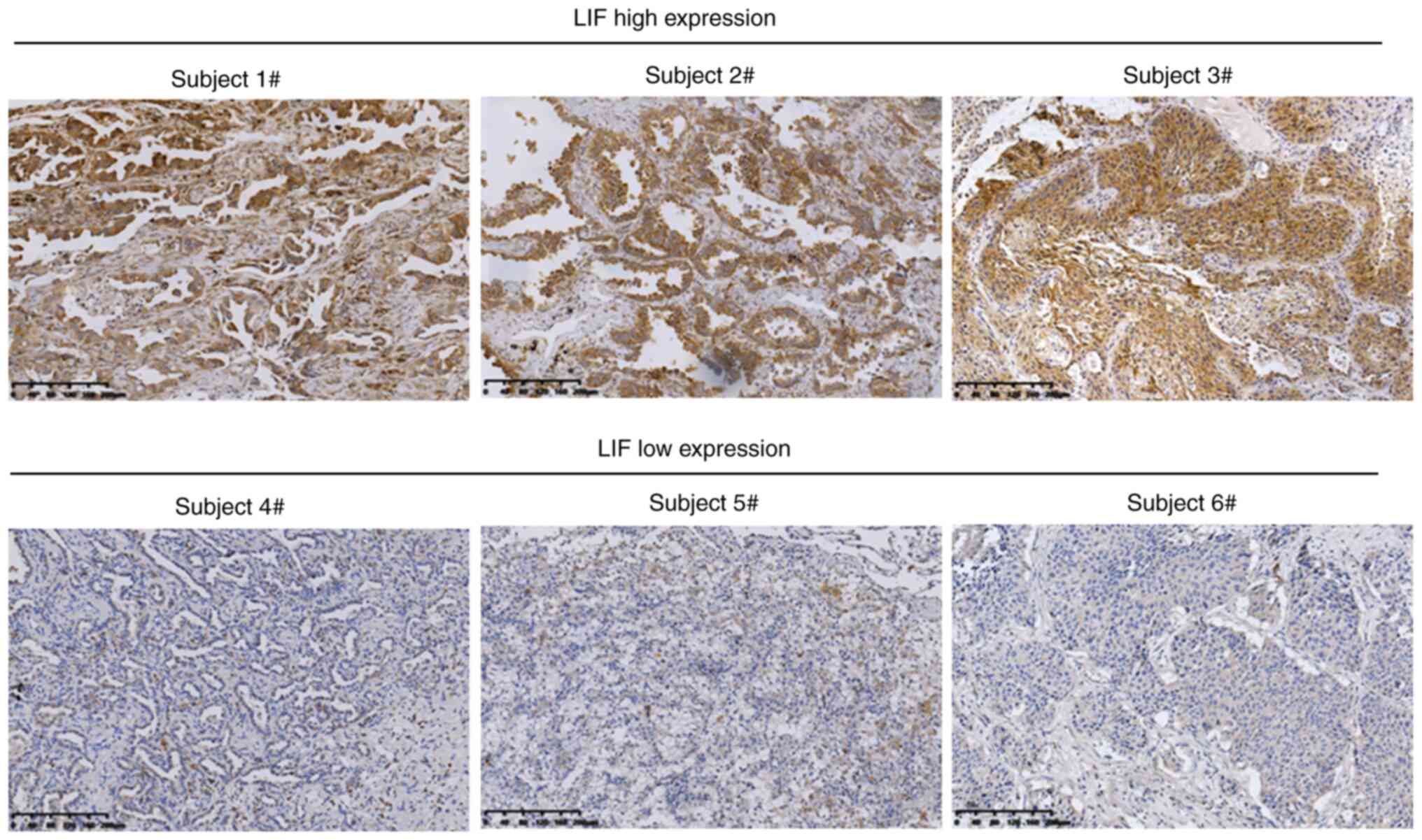|
1
|
Bray F, Ferlay J, Soerjomataram I, Siegel
RL, Torre LA and Jemal A: Global cancer statistics 2018: GLOBOCAN
estimates of incidence and mortality worldwide for 36 cancers in
185 countries. CA Cancer J Clin. 68:394–424. 2018. View Article : Google Scholar : PubMed/NCBI
|
|
2
|
Xiong D, Zhu SQ, Wu YB, Jin C, Jiang JH,
Liao YF, Long X, Wu HB, Xu JJ, Li JJ and Ding JY: Ring finger
protein 38 promote non-small cell lung cancer progression by
endowing cell EMT phenotype. J Cancer. 9:841–850. 2018. View Article : Google Scholar : PubMed/NCBI
|
|
3
|
Pirker R: Conquering lung cancer: Current
status and prospects for the future. Pulmonology. 26:283–290. 2020.
View Article : Google Scholar : PubMed/NCBI
|
|
4
|
Scrima M, Zito Marino F, Oliveira DM,
Marinaro C, La Mantia E, Rocco G, De Marco C, Malanga D, De Rosa N,
Rizzuto A, et al: Aberrant signaling through the HER2-ERK1/2
pathway is predictive of reduced disease-free and overall survival
in early stage non-small cell lung cancer (NSCLC) Patients. J
Cancer. 8:227–239. 2017. View Article : Google Scholar : PubMed/NCBI
|
|
5
|
Rotow J and Bivona TG: Understanding and
targeting resistance mechanisms in NSCLC. Nat Rev Cancer.
17:637–658. 2017. View Article : Google Scholar : PubMed/NCBI
|
|
6
|
Nicola NA and Babon JJ: Leukemia
inhibitory factor (LIF). Cytokine Growth Factor Rev. 26:533–544.
2015. View Article : Google Scholar : PubMed/NCBI
|
|
7
|
Dahéron L, Opitz SL, Zaehres H, Lensch MW,
Andrews PW, Itskovitz-Eldor J and Daley GQ: LIF/STAT3 signaling
fails to maintain self-renewal of human embryonic stem cells. Stem
Cells. 22:770–778. 2004. View Article : Google Scholar
|
|
8
|
Niwa H, Ogawa K, Shimosato D and Adachi K:
A parallel circuit of LIF signalling pathways maintains
pluripotency of mouse ES cells. Nature. 460:118–122. 2009.
View Article : Google Scholar : PubMed/NCBI
|
|
9
|
Pera MF and Tam PP: Extrinsic regulation
of pluripotent stem cells. Nature. 465:713–720. 2010. View Article : Google Scholar : PubMed/NCBI
|
|
10
|
Wysoczynski M, Miekus K, Jankowski K,
Wanzeck J, Bertolone S, Janowska-Wieczorek A, Ratajczak J and
Ratajczak MZ: Leukemia inhibitory factor: A newly identified
metastatic factor in rhabdomyosarcomas. Cancer Res. 67:2131–2140.
2007. View Article : Google Scholar : PubMed/NCBI
|
|
11
|
Liu SC, Tsang NM, Chiang WC, Chang KP,
Hsueh C, Liang Y, Juang JL, Chow KP and Chang YS: Leukemia
inhibitory factor promotes nasopharyngeal carcinoma progression and
radioresistance. J Clin Invest. 123:5269–5283. 2013. View Article : Google Scholar : PubMed/NCBI
|
|
12
|
Yu H, Yue X, Zhao Y, Li X, Wu L, Zhang C,
Liu Z, Lin K, Xu-Monette ZY, Young KH, et al: LIF negatively
regulates tumour-suppressor p53 through Stat3/ID1/MDM2 in
colorectal cancers. Nat Commun. 5:52182014. View Article : Google Scholar : PubMed/NCBI
|
|
13
|
Lin TA, Wu TS, Li YJ, Yang CN, Illescas
Ralda MM and Chang HH: Role and mechanism of LIF in oral squamous
cell carcinoma progression. J Clin Med. 9:2952020. View Article : Google Scholar : PubMed/NCBI
|
|
14
|
Hergovich A: YAP-Hippo signalling
downstream of leukemia inhibitory factor receptor: Implications for
breast cancer. Breast Cancer Res. 14:3262012. View Article : Google Scholar : PubMed/NCBI
|
|
15
|
Chen D, Sun Y, Wei Y, Zhang P, Rezaeian
AH, Teruya-Feldstein J, Gupta S, Liang H, Lin HK, Hung MC and Ma L:
LIFR is a breast cancer metastasis suppressor upstream of the
Hippo-YAP pathway and a prognostic marker. Nat Med. 18:1511–1517.
2012. View
Article : Google Scholar : PubMed/NCBI
|
|
16
|
Humbert L, Ghozlan M, Canaff L, Tian J and
Lebrun JJ: The leukemia inhibitory factor (LIF) and p21 mediate the
TGFβ tumor suppressive effects in human cutaneous melanoma. BMC
Cancer. 15:2002015. View Article : Google Scholar : PubMed/NCBI
|
|
17
|
Luo Q, Wang C, Jin G, Gu D, Wang N, Song
J, Jin H, Hu F, Zhang Y, Ge T, et al: LIFR functions as a
metastasis suppressor in hepatocellular carcinoma by negatively
regulating phosphoinositide 3-kinase/AKT pathway. Carcinogenesis.
36:1201–1212. 2015. View Article : Google Scholar : PubMed/NCBI
|
|
18
|
Wu L, Yu H, Zhao Y, Zhang C, Wang J, Yue
X, Yang Q and Hu W: HIF-2α mediates hypoxia-induced LIF expression
in human colorectal cancer cells. Oncotarget. 6:4406–4417. 2015.
View Article : Google Scholar : PubMed/NCBI
|
|
19
|
Shiao YH, Palli D, Caporaso NE, Alvord WG,
Amorosi A, Nesi G, Saieva C, Masala G, Fraumeni JF Jr and Rice JM:
Genetic and immunohistochemical analyses of p53 independently
predict regional metastasis of gastric cancers. Cancer Epidemiol
Biomarkers Prev. 9:631–633. 2000.PubMed/NCBI
|
|
20
|
Morse DL, Carroll D, Weberg L, Borgstrom
MC, Ranger-Moore J and Gillies RJ: Determining suitable internal
standards for mRNA quantification of increasing cancer progression
in human breast cells by real-time reverse transcriptase polymerase
chain reaction. Anal Biochem. 342:69–77. 2005. View Article : Google Scholar : PubMed/NCBI
|
|
21
|
Guha P, Gardell J, Darpolor J, Cunetta M,
Lima M, Miller G, Espat NJ, Junghans RP and Katz SC: STAT3
inhibition induces Bax-dependent apoptosis in liver tumor
myeloid-derived suppressor cells. Oncogene. 38:533–548. 2019.
View Article : Google Scholar : PubMed/NCBI
|
|
22
|
Moreau JF, Donaldson DD, Bennett F,
Witek-Giannotti J, Clark SC and Wong GG: Leukaemia inhibitory
factor is identical to the myeloid growth factor human interleukin
for DA cells. Nature. 336:690–692. 1988. View Article : Google Scholar : PubMed/NCBI
|
|
23
|
Li X, Yang Q, Yu H, Wu L, Zhao Y, Zhang C,
Yue X, Liu Z, Wu H, Haffty BG, et al: LIF promotes tumorigenesis
and metastasis of breast cancer through the AKT-mTOR pathway.
Oncotarget. 5:788–801. 2014. View Article : Google Scholar : PubMed/NCBI
|
|
24
|
Kuphal S, Wallner S and Bosserhoff AK:
Impact of LIF (leukemia inhibitory factor) expression in malignant
melanoma. Exp Mol Pathol. 95:156–165. 2013. View Article : Google Scholar : PubMed/NCBI
|
|
25
|
Wang D, Liu K, Yang Y, Wang T, Rao Q, Guo
W and Zhang Z: Prognostic value of leukemia inhibitory factor and
its receptor in pancreatic adenocarcinoma. Future Oncol.
16:4461–4473. 2020. View Article : Google Scholar : PubMed/NCBI
|
|
26
|
McLean K, Tan L, Bolland DE, Coffman LG,
Peterson LF, Talpaz M, Neamati N and Buckanovich RJ: Leukemia
inhibitory factor functions in parallel with interleukin-6 to
promote ovarian cancer growth. Oncogene. 38:1576–1584. 2019.
View Article : Google Scholar : PubMed/NCBI
|
|
27
|
Takahashi Y, Takahashi M, Carpino N, Jou
ST, Chao JR, Tanaka S, Shigeyoshi Y, Parganas E and Ihle JN:
Leukemia inhibitory factor regulates trophoblast giant cell
differentiation via Janus kinase 1-signal transducer and activator
of transcription 3-suppressor of cytokine signaling 3 pathway. Mol
Endocrinol. 22:1673–1681. 2008. View Article : Google Scholar : PubMed/NCBI
|
|
28
|
Heinrich PC, Behrmann I, Haan S, Hermanns
HM, Müller-Newen G and Schaper F: Principles of interleukin
(IL)-6-type cytokine signalling and its regulation. Biochem J.
374:1–20. 2003. View Article : Google Scholar : PubMed/NCBI
|
|
29
|
Watanabe S, Umehara H, Murayama K, Okabe
M, Kimura T and Nakano T: Activation of Akt signaling is sufficient
to maintain pluripotency in mouse and primate embryonic stem cells.
Oncogene. 25:2697–2707. 2006. View Article : Google Scholar : PubMed/NCBI
|
|
30
|
Metcalf D: The unsolved enigmas of
leukemia inhibitory factor. Stem Cells. 21:5–14. 2003. View Article : Google Scholar : PubMed/NCBI
|
|
31
|
Yue X, Zhao Y, Zhang C, Li J, Liu Z, Liu J
and Hu W: Leukemia inhibitory factor promotes EMT through
STAT3-dependent miR-21 induction. Oncotarget. 7:3777–3790. 2016.
View Article : Google Scholar : PubMed/NCBI
|
|
32
|
Yang M, Chen H, Zhou L, Chen K and Su F:
Expression profile and prognostic values of STAT family members in
non-small cell lung cancer. Am J Transl Res. 11:4866–4880.
2019.PubMed/NCBI
|
|
33
|
Lassmann S, Schuster I, Walch A, Göbel H,
Jütting U, Makowiec F, Hopt U and Werner M: STAT3 mRNA and protein
expression in colorectal cancer: Effects on STAT3-inducible targets
linked to cell survival and proliferation. J Clin Pathol.
60:173–179. 2007. View Article : Google Scholar : PubMed/NCBI
|
|
34
|
Lin L, Liu A, Peng Z, Lin HJ, Li PK, Li C
and Lin J: STAT3 is necessary for proliferation and survival in
colon cancer-initiating cells. Cancer Res. 71:7226–7237. 2011.
View Article : Google Scholar : PubMed/NCBI
|
|
35
|
Grivennikov S, Karin E, Terzic J, Mucida
D, Yu GY, Vallabhapurapu S, Scheller J, Rose-John S, Cheroutre H,
Eckmann L and Karin M: IL-6 and Stat3 are required for survival of
intestinal epithelial cells and development of colitis-associated
cancer. Cancer Cell. 15:103–113. 2009. View Article : Google Scholar : PubMed/NCBI
|
|
36
|
Bollrath J, Phesse TJ, von Burstin VA,
Putoczki T, Bennecke M, Bateman T, Nebelsiek T, Lundgren-May T,
Canli O, Schwitalla S, et al: gp130-mediated Stat3 activation in
enterocytes regulates cell survival and cell-cycle progression
during colitis-associated tumorigenesis. Cancer Cell. 15:91–102.
2009. View Article : Google Scholar : PubMed/NCBI
|
|
37
|
Jiang R, Jin Z, Liu Z, Sun L, Wang L and
Li K: Correlation of activated STAT3 expression with
clinicopathologic features in lung adenocarcinoma and squamous cell
carcinoma. Mol Diagn Ther. 15:347–352. 2011. View Article : Google Scholar : PubMed/NCBI
|
|
38
|
Tian Y, Yu M, Sun L, Liu L, Wang J, Hui K,
Nan Q, Nie X, Ren Y and Ren X: Distinct Patterns of mRNA and lncRNA
expression differences between lung squamous cell carcinoma and
adenocarcinoma. J Comput Biol. 27:1067–1078. 2020. View Article : Google Scholar : PubMed/NCBI
|
|
39
|
Zhang XC, Wang J, Shao GG, Wang Q, Qu X,
Wang B, Moy C, Fan Y, Albertyn Z, Huang X, et al: Comprehensive
genomic and immunological characterization of Chinese non-small
cell lung cancer patients. Nat Commun. 10:17722019. View Article : Google Scholar : PubMed/NCBI
|
|
40
|
Kim H, Kwon HJ, Park SY, Park Y, Park E
and Chung JH: Clinicopathological analysis and prognostic
significance of programmed cell death-ligand 1 protein and mRNA
expression in non-small cell lung cancer. PLoS One.
13:e01986342018. View Article : Google Scholar : PubMed/NCBI
|
|
41
|
Liu S, Wang X, Qin W, Genchev GZ and Lu H:
Transcription factors contribute to differential expression in
cellular pathways in lung adenocarcinoma and lung squamous cell
carcinoma. Interdiscip Sci. 10:836–847. 2018. View Article : Google Scholar : PubMed/NCBI
|















